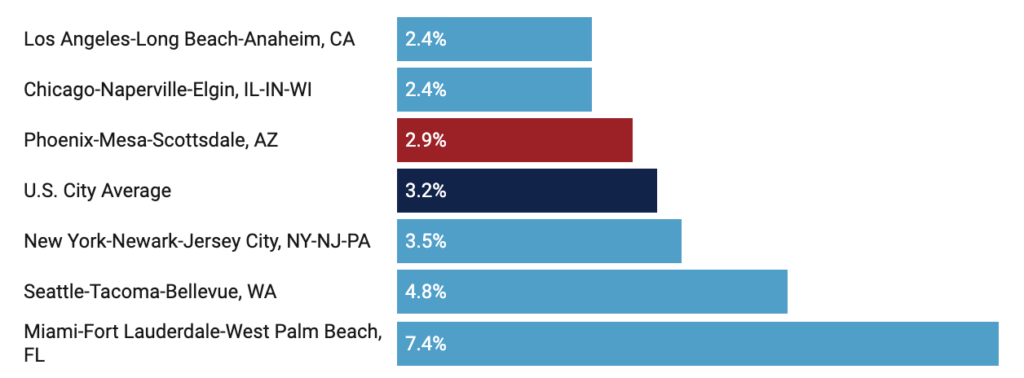Phoenix all-items inflation was slightly below the U.S. in October.
The Consumer Price Index for All Urban Consumers (CPI-U), often referred to as CPI, serves as an economic indicator that measures the change in prices paid by consumers for goods and services. This index, maintained by the U.S. Bureau of Labor Statistics, offers insights into the fluctuations in the cost of living. To provide a regional perspective on the inflation areas across the U.S., data is presented for selected metropolitan areas in each region of the nation. Consumer price indexes for many other metropolitan areas are available from the U.S. Bureau of Labor Statistics.
MORE NEWS: 17 inventions that haven’t been invented yet (that people want)
The CPI-U for all items provides an overview of the general cost of living, encompassing a range of goods and services. In October 2023, the year-over-year increase in the Consumer Price Index for all items in the Phoenix MSA was 2.9%, just below the U.S. City Average of 3.2%. While Phoenix was in line with the national average, the Miami-Fort Lauderdale-West Palm Beach MSA recorded the highest year-over-year increase among the tracked MSAs, coming in at 7.4%. On the other end of the spectrum, the Chicago-Naperville-Elgin and the Los Angeles-Long Beach-Anaheim MSAs had the lowest increase in the group, reporting at 2.4% year over year.
Exhibit 1: All Items Consumer Price Index for All Urban Consumers in October 2023, Nonseasonally-Adjusted, Annual Percent Change

The CPI-U for all items less food and energy gets considerable attention as a measure of underlying core inflation, since it is not subject to the volatile movements of food and energy prices. In October, Phoenix’s inflation rate for all items less food and energy was recorded at 3.2% year over year. This figure was below the national all items less food and energy inflation rate, which stood at 4.0% year over year. Among the tracked MSAs, the Miami-Fort Lauderdale-West Palm Beach MSA experienced the highest inflation, reaching 8.0% year over year, while the Los Angeles-Long Beach-Anaheim MSA had the lowest increase at 2.7% year over year.
Exhibit 2: All items Less Food and Energy Consumer Price Index for All Urban Consumers in October 2023, Nonseasonally-Adjusted, Annual Percent Change

The CPI-U for commodities is a sub-index of the all-items CPI-U, measuring the change in prices for tangible items such as fuel, food, appliances, furniture, vehicles, etc. In October 2023, the data indicated that the Phoenix MSA displayed the lowest inflation rate among major metropolitan areas, experiencing a decrease of -0.7% year over year. In contrast, the national commodities inflation rate came in at 0.4% year over year. Notably, the Miami-Fort Lauderdale-West Palm Beach, FL metropolitan area recorded the highest commodities inflation rate of 2.5% year over year.
Exhibit 3: Commodities Consumer Price Index for All Urban Consumers in October 2023, Nonseasonally-Adjusted, Annual Percent Change

In contrast to commodities, the services index tracks changes in prices for intangible items such as healthcare, education, transportation, housing, etc., reflecting the overall cost movement within this sector. The Phoenix MSA recorded a rate of 5.0% for services inflation in October, slightly below the national average of 5.1%. The Miami-Fort Lauderdale-West Palm Beach MSA stood out with the highest services inflation among the tracked MSAs at 9.6%, while the Los Angeles-Long Beach-Anaheim MSA had the lowest, maintaining a relatively lower services inflation rate at 3.9%.
Exhibit 4: Services Consumer Price Index for All Urban Consumers in October 2023, Nonseasonally-Adjusted, Annual Percent Change

The shelter CPI-U index tracks the monthly change in the cost of housing services for both homeowners and renters (and short-term rentals like hotels). It is important to note that shelter is a major component of the services index. In October, the Phoenix MSA reported a shelter inflation rate of 6.3% year over year, which was below the U.S. city average at 6.7% year over year. Miami-Fort Lauderdale-West Palm Beach MSA stood out among the MSAs with a significant increase of 11.9% year over year. Los Angeles-Long Beach-Anaheim MSA, in contrast showed the slowest growth in the group, coming in at 4.4% year over year.
Exhibit 5: Shelter Consumer Price Index for All Urban Consumers in October 2023, Nonseasonally-Adjusted, Annual Percent Change

Author: Prarthana Magon is an Undergraduate Research Assistant at Eller Business Research Center.




